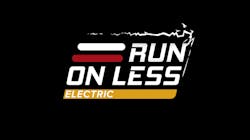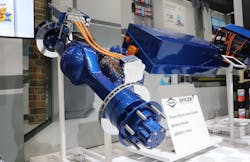To help the transportation industry validate the merits and unravel the challenges of battery-electric vehicles, the North American Council for Freight Efficiency (NACFE) and Rocky Mountain Institute are making the next Run on Less exclusively electric. Run on Less – Electric (ROL-E) will take place for around three weeks in September 2021 to measure the real-world performance and capabilities of 10 electric trucks, potentially ranging from Class 3 to 8, as well as onboard equipment and technology and existing charging infrastructure.
The event will officially conclude with a wrap-up presentation at the North American Commercial Vehicle show in Atlanta, held this year from Sept. 28-30. The first Run On Less took place in 2017 and tested general Class 8 fuel-efficiency boosting equipment, while the 2019 outing focused on regional haul. Run on Less Regional found that truck outfitted with aero kits, low rolling resistant tires and other efficiency equipment could increase the regional haul average from 6 mpg to 8.3 mpg.
“We will be bringing what NACFE always does: the benefits, the challenges, the pros, the cons, the issues, the struggles, as well as what's going well,” said NACFE executive director Mike Roeth, who noted unlike in the past, this ROL-E will involve fleets and OEMs to reflect the current validations, such as with the Volvo LIGHTS project.
NACFE expects participating vehicles to possibly include panel vans and medium-duty box trucks used for e-commerce and pickup and delivery, along with heavy-duty trucks performing drayage and regional hauls in the U.S. and Canada. Roeth said yard tractors are also being considered. Long haul is not yet feasible as battery ranges have not yet crested 200 miles per charge. Interested parties can visit NACFE’s website to register. In March, NACFE will pick the fleets and announce their decision in April.
Qualitative over quantitative
Due to the nascent technology involved in electrifying trucks, this year’s version will be more qualitative than quantitative, Roeth acknowledged. The metrics NACFE will measure should likely revolve around battery charging, such as day versus night differences, fast charging and opportunity charging (in 24/7 applications).
“We'll also be looking at the duty cycle, so miles, stops, speed, all those types of things,” Roeth added.
The true goal for ROL-E is to serve as an electric bellwether for the industry, to show where electric trucks perform well and where they need to improve.
Roeth said the participating fleets will be tested in “places where the electric truck fits the fleet operations, but also are ones that are highly valuable.”
And though NACFE will generate data drips rather than data lakes, testing real electric trucks in real applications will provide valuable insights.
“We will definitely have uncovered throughout the run challenges for electric trucks,” Roeth said. “We know they're out there, and those will come out as we tell the stories of the infrastructure and the operation of the trucks and if drivers like them or not, and how we’re going to finance the trucks.”
Finding out where electrification will truly help fleets is something of great value to Tier One suppliers and vendors, as well. ROL-E sponsors include axle and drivetrain manufacturers Dana Inc. and Meritor Inc, as well as Shell, which owns charging infrastructure solution provider Greenlots.
“Potentially some of the things we'll find or discover and measure would be the improvement in duty cycle response if having an electric propulsion system with rapid start and stop capability versus internal combustion engine can be a benefit, in addition to some of the driver nuances the drivers,” said Steve Slesinski, director of product planning at Dana. “We think they will prefer the electric propulsion system because they're much quieter and much more responsive to operate.”
Slesinski expects electric pickup and delivery applications to be an early achiever, as daily routes are under 100 miles, so batteries can be smaller, allowing payload to be higher.
Greenlots, an instrumental player in the Volvo LIGHTS project for supplying and managing the software that controls the charging on the supply end, is also excited to get more intel on several different duty cycles. The company has a mature understanding of passenger vehicle charging, and its Level 2 fast-charging technology allowed Yellow Cab of Columbus’ taxi fleet to cut costs by 50%.
“There are a lot of opportunities really on the software side and the charging infrastructure side, to manage surcharging to reflect not only the operational efficiencies but also the time of use, when the drivers or when the commercial business needs the full charge,” Greenlots CEO Andreas Lips explained.
Lips added while fleets are always aiming for a better total cost of ownership, they also need to maintain operational efficiency and their sustainability goals.
“There's no doubt that overall trucks disproportionately contribute to air pollution, so [ROL-E] is a great initiative to actually try to tackle that overall,” Lips said. “The real opportunity is to learn together with our customers and in real-case scenarios.
For Ryan Obert, director of product marketing for Meritor, the chance to see 10 different electrification deployments provides opportunities for learning and to make his work a bit more exciting.
He talked about how his regular job discussing truck components at industry shows and events that have been around for decades can become monotonous.
“When somebody asks what you do and you [tell them] you manufacture brakes and axles for semi-trucks and their eyes kind of glaze over and they find somebody more interesting to talk to,” Obert recalled. “When I talk about taking a gigantic 2,000-lb. diesel engine and transmission out of the equation and powering a school bus with an electric axle, then everybody starts asking questions. And so it is a hot topic.”
Aside from that, the insights gathered from the event could help Meritor improve its Blue Horizon line of electric drivetrain and e-axle parts
“It's good timing,” Obert said. “We're seeing more adoption, we're seeing more maturity, they're proving out these technologies in the real world, so I think now it's time to really show the industry.”
Learning curve
Leading up to September, NACFE will offer an electrification education series that gives attendees an understanding of the electric truck market and where it’s heading, along with specialty sessions on infrastructure and finance. There will be 10 webinars 90 minutes in length between May and September.
“We're all starting to get our feet wet,” said Rob Reich, NACFE Board Chairman and Schneider's EVP and chief administrative officer. “And I think that makes it a great opportunity and a great time to do this, because it's so different. You look at any of our careers, this is such a significant change in the trucking technology, that it just makes sense for us to get ahead of that and really help the industry learn.”
About the Author
John Hitch
Editor
John Hitch is the editor-in-chief of Fleet Maintenance, providing maintenance management and technicians with the the latest information on the tools and strategies to keep their fleets' commercial vehicles moving. He is based out of Cleveland, Ohio, and was previously senior editor for FleetOwner. He previously wrote about manufacturing and advanced technology for IndustryWeek and New Equipment Digest.




